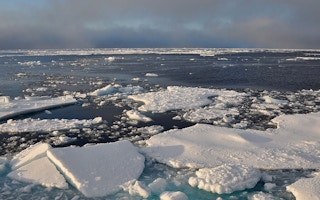Climate scientists have known for years that the Arctic is warming far faster than anywhere else on the planet.
But even those of us who follow the Arctic closely were shocked by the changes that occurred in 2020, a year of broken records, retreating glaciers, and shattering ice sheets. The alarm bells are ringing louder than ever: we must urgently and drastically reduce our greenhouse-gas emissions.
Last year, temperatures in the Arctic Circle reached their highest-ever recorded levels. A heat wave in Arctic Siberia brought temperatures of 38°C (100°F) – 18°C higher than the average maximum daily temperature in past years.
“
During the Covid-19 pandemic, “build back better” has become something of a mantra. Measures to preserve the Arctic must be at the center of this effort.
Meanwhile, fierce Arctic wildfires released a record-breaking level of carbon dioxide and set a new pollution record for the region.
With the heat turned up, the Arctic landscape has been changing fast. For the first time since records began, sea ice in the Arctic’s Eurasian sector had not yet begun freezing in October.
The previous month, an ice sheet the size of Paris broke off from Greenland’s largest glacier shelf, and in July, Canada’s intact ice shelf – 4,000 years old – fragmented. As Arctic ice melts, sea levels rise, threatening countries worldwide.
Over the last year, scientists have also spotted worrying signs of future climate breakdown. As higher temperatures cause Arctic plants to grow taller, permafrost is thawing faster – a process that releases enormous amounts of carbon dioxide and methane (a far more potent greenhouse gas than CO2), accelerating the temperature rise.
Last year, a 164-foot-deep crater or “funnel,” one of many reported in recent years, was found in northern Siberia after an underground pocket of methane, formed by melting permafrost, burst through the tundra.
The consequences of climate collapse in the Arctic are wide-ranging. A fuel tank cracked open in the Russian Arctic after settling into softened permafrost, releasing about 150,000 barrels of diesel into a river.
A Human Rights Watch report found that climate-related changes in animal migration patterns are making it harder for indigenous communities in Canada to find food or traverse previously frozen bodies of water. And coastal villages can be devastated when fish species migrate to escape warming waters.
These stories might seem distant, even abstract, to most readers. But this will not remain true for long. If the events of 2020 have shown us anything, it is that what happens in the Arctic does not stay there. On the contrary, rising Arctic temperatures threaten to trigger a devastating domino effect that ends in global catastrophe.
That is because of two powerful natural phenomena. First, Arctic warming weakens the jet stream – the river of air that flows high above Earth’s surface.
The jet stream is propelled by the contrast between the planet’s frozen poles and its hot equator. As that contrast is diminished, the jet stream slows and even stagnates.
Scientists believe this change in the jet stream is behind a number of deadly weather events, including wildfires in California and Siberia, extreme winter storms in the Eastern United States, and record-high temperatures in the Mojave Desert.
The second way Arctic warming affects the rest of the world is by disrupting the polar vortex, a low-pressure weather system that sits above each pole and keeps cold air there.
As the Arctic warms, the cold air contained in the polar vortex is thought to be displaced and moved to the south, leading to extreme and unusual cold weather in faraway places. This winter, Italy, Japan, and Spain experienced extreme snowfall.
During the Covid-19 pandemic, “build back better” has become something of a mantra. Measures to preserve the Arctic must be at the center of this effort. To aid in this process, Arctic Basecamp, which I founded, will be developing an open-access Arctic Risk platform this year, to highlight early warning signs of emerging risks caused by changes in the Arctic ecosystem.
Fortunately, a growing number of decision-makers seem to recognise the Arctic’s critical importance. The World Economic Forum’s recently released “Global Risks Report 2021” ranked extreme weather, weak climate action, and human-induced environmental damage among the most likely – and highest-impact – risks we face over the next decade.
During the WEF’s Davos Agenda week, I led a high-level panel aimed at accelerating progress toward protecting this critical region.
It is comforting to imagine the Arctic as a snowy faraway place, populated by reindeer and polar bears. In fact, it is a cornerstone of the climate system that keeps our weather stable, our communities habitable, and our economies prosperous.
And it is under immense pressure. Relieving that pressure – especially by ending all mining for oil and gas – is a prerequisite for a more sustainable and equitable world.
Gail Whiteman is Founder of Arctic Basecamp, a team of Arctic experts and scientists.
Copyright: Project Syndicate, 2020.
www.project-syndicate.org









